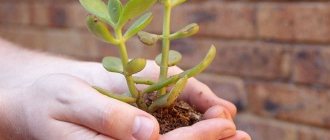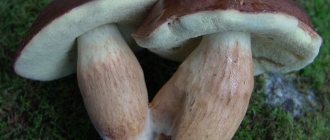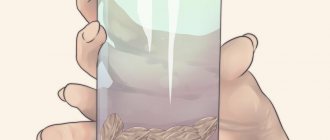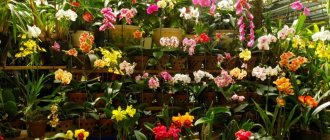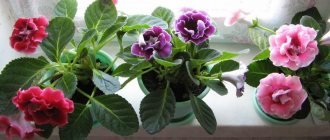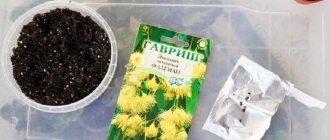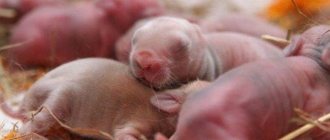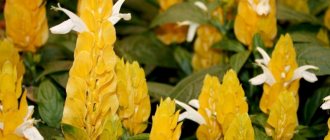People call it the tree of happiness and love. This name has stuck to the plant due to its leaves, which resemble small hearts in shape. Of course, this succulent will decorate any room with its appearance. In this article we will answer all the main questions of interest to flower growers and hobbyists.
Aichrizon is a succulent evergreen perennial. It forms a spherical bush 20-30 cm high. In its natural environment it grows on rocky cliffs and in rock breaks. The rhizome is highly branched and located in the upper layers of the soil.
About one and a half dozen varieties of Aichrizon are known, but only five have gained particular popularity for breeding at home among Russian indoor plant lovers.
Domestic varieties
Aichryson x domesticum
A selected species, the basis for breeding was the Sinuous and Pointed Aichrizones. The spherical bush shape is formed due to the good branching of the plant. It grows up to three tens of centimeters both upward and in width.
The stems end in rosettes, collected from small (two centimeters) leaves of a fleshy structure, rich green in color with white pubescence on the plate. Long (two-thirds of the bush) peduncles are sprinkled with small fragrant flowers of yellow shades. It is possible to admire a flowering plant for up to six months under favorable conditions.
Aichrizon home
Aichryson tortuosum
The ancestor of the previous species has similar growth characteristics in size and shape. The differences are the shortened stem of the diamond-shaped leaf, the proportionality of the length of the shoots with the diametrical size of the collected rosettes. The leaf surfaces are covered with silvery pile on a light green background. Flowering begins in the last spring month and can last until November. The flowers are beige in color.
Aichrizon sinuous
Aichryson sedifolium
The semi-shrub succulent reaches up to forty centimeters in height and is not very voluminous (up to 13 given measurement units). Thin straight branches bear rosette endings of fleshy, closely spaced, club-shaped leaves with no pubescence. The leaf surface is painted in delicate green tones with the addition of yellow and red shades.
Flowering occurs in the second half of spring and lasts only a couple of months. Yellow and gold flowers, collected in large inflorescences, frame the Aichrizon. During this period and dormant state, partial fall of the foliage is characteristic.
Aichrizon sedum-leaved
Aichryson laxum
The wide, square-shaped bush species is not inferior in height to its predecessor, and even surpasses in width. It is distinguished by diamond-shaped fluffy leaves located throughout the shoot on long petioles. The color of the foliage is green tones. Small sunny stars of flowers in voluminous inflorescences decorate the plant for six months, starting in spring. With the last faded flowers, succulents are freed from most of their foliage.
Aichrizon prostrate
Aichryson punctatum
The stems of the bush, covered with translucent thick fibers, stretch out a little, not reaching half a meter. The main tone of the shoots is green with a brown addition. The leaves on long petioles are arranged in a rosette manner, colored green with weaker pubescence (compared to the branches). Small, star-shaped flowers are located in yellow inflorescences of a loose shield. The plant is covered with a veil of stars for six months.
Aichrizon point
Care
Aichrizone varieties are unpretentious in maintenance. If you follow simple plant care rules, they can get along well in not entirely suitable conditions. The main criteria for choosing a location are to be away from household appliances and heating devices, and to have a well-lit place. East or west windows would be a good placement. In summer, outdoor use (loggia, balcony) should be provided.
Watering
- Succulent representatives of the plant world do not require abundant watering. Due to the accumulative property of leaves and stem shoots in retaining moisture, they are able to receive water in small portions at long intervals (from three to five days). During the frosty season, the frequency of soil moisture is reduced compared to spring and summer.
- Elastic leaf plates indicate sufficient moisture. The appearance of wrinkles and lethargy signals that the bush is “thirsty.” Flower growers with accumulated personal knowledge use a fairly simple method for determining the need for watering. Just press lightly with your palm on the upper part of the crown, and the response (elastic resistance or flaccidity) will indicate the required actions.
- Soil stagnation of moisture leads to the development of root rotting. From this follows a confident assumption that more damage is caused by waterlogging than by drying out the earthen coma. If the soil substrate dries out, watering should be done in small portions at frequent intervals (once every two days) while monitoring the condition of the plant.
- The natural humidity of the room is sufficient for all types of Aichrizone. Showering with warm water is allowed in the summer. Held twice a month. And this action is strictly contraindicated during the dormant period of the succulent.
Lighting
Direct rays of the sun can cause burns to the moisture-saturated fleshy parts of the flower. So the incoming light should be bright, but necessarily diffused. This can be achieved by using a tulle or marching curtain. When placed on the south side, you can use the adjacent surfaces of a table or chest of drawers as a stand. Daylight hours are up to 14 hours.
The uniform development of the crown is achieved by turning the flower pot. With a one-sided position towards the light, crown asymmetry develops. The plant gets skewed towards the illuminated place. A shift in the center of gravity can cause the bush to fall. Considering the fragility of representatives of the Tolstyankov family, damage cannot be avoided.
Temperature
During intensive growth and flowering period (from mid-spring to October), air heating is optimal at 23 degrees Celsius (a rise and fall of readings of 2 degrees is acceptable). During hot hours, when kept indoors, it is necessary to arrange frequent ventilation.
From autumn to spring, the plant rests and gains strength for the next warm season. At this stage, comfort is achieved by a cool temperature (about ten degrees above zero). A higher temperature will prevent hibernation from occurring. The weakened plant creature will continue to grow with the loss of leaves and elongation of shoots.
The soil
For the root system of Aichrizon, a self-prepared soil composition is suitable. For this purpose, turf and peat soils, coarse sand and medium gravel or expanded clay (to ensure drainage) are used in equal proportions. Birch charcoal pieces will serve as a good addition to the resulting soil.
Good bush formation and splendor will be achieved by complex fertilizers used during the warm period. It should be fed once for two weeks. The presence of the nitrogen component should be minimal. During the dormant period (winter), the plant does not need additional nutrients.
Transfer
Moving from one container to another is carried out as necessary. Don't bother Aichrizon too often. Performed in the spring, before flowering begins. The clay version of the container product is preferable. Good breathability and porosity ensures the removal of excess moisture and promotes root respiration. This procedure is carried out for several reasons.
- Buying a pet. Replacing store-bought primer is the recommended procedure. During the process, the condition of the roots and the volume of the pot are assessed. Prevention of root rot is carried out.
- Proliferation of the root system. When the earthen ball is entwined with roots so that the earth is not visible, a new pot is selected. A flat pot with low sides works well. The location of the roots occupies the upper soil layer, without deep penetration.
- Very spacious container. In this case, the flowering time can be delayed indefinitely. To prevent this from happening, a smaller vessel is selected.
The general rules for transplantation are simple. A new pot is being selected. A drainage layer (expanded clay, pebbles, brick chips) is laid on the bottom. An old ball of earth rolls over the top, pierced lengthwise and crosswise by roots. Fresh soil of a special composition is added to the level. Pieces of birch charcoal added to the ground serve as prophylaxis against various types of rot.
The first watering after transplantation is carried out on the fifth – ninth day of adaptation. It is done very carefully, in small portions, in order to protect the plant from flooding. Incorrect actions can lead to a deterioration in the condition of Aichrison. Evidence of the onset of the problem will be wrinkling and yellowing of the leaf part of the crown.
Reproduction
Obtaining new specimens within a species does not require much effort. Reproduction methods include cuttings and sowing seeds.
Seed cultivation
- Flat containers with low sides are filled with prepared soil. The recipe is simple: one part of leaf soil is mixed with half of clean sand. The seeds are placed at a depth of half a centimeter.
- It is recommended to cover the container with a glass lid or film. This mini greenhouse is placed in a bright, warm (up to 20 degrees plus) place. The soil surface is sprayed and ventilated regularly. Performed once a day.
- After a couple of weeks, the first shoots appear. At the stage of three or four leaves, the seedlings are transplanted into the next bowl. Between plantings, a distance of five centimeters is maintained, and lighting is added.
- The soil composition changes slightly. An equal amount of sandy part of the turf (light) soil is mixed into the previous filling. No covering is required from this stage. Protect fragile seedlings from direct sunlight.
- The final step is the final transplantation of young, strong plants into individual pots with a diameter of no more than 70 millimeters. The bottom is lined with drainage material and filled with a new soil base. The soil is used for succulent species.
- The temperature is maintained two degrees lower than at the germination stage. It is necessary to water every day in small portions to moisten the earthen clod, without excess.
Propagation by cuttings
A faster and easier option for getting your own plant. It is held at the beginning of the spring season (March, April). Planting material is selected from crown formation scraps, or the selected shoot is cut off.
A cutting of nine centimeters in length is selected and dried in a shady place for two hours until the next day. Further rooting can be carried out in two directions. Place in boiled water with the addition of activated carbon until the first roots appear.
It is practiced to place the prepared cuttings directly into a substrate for succulents (ready-made or home-made), wet sand, vermiculite (a moisture-containing mineral with a layered structure). Sprouted and strengthened “babies” are placed according to the same rules as grown seedlings. Care is carried out adhering to the above parameters. Young specimens will grow and gain strength earlier than their seed counterparts.
Addition:
There are situations where there is a lack of suitable material for propagation or preservation of dying Aichrizon. It is enough to find a healthy leaf and lightly drown it in prepared moist soil. After some time, the formation of the root system will begin. And from one leaf it is possible to raise a new young succulent.
Reproduction of aichrizon at home
Aichrysons are propagated by seeds or cuttings. Sow the seeds in shallow bowls filled with leaf soil (1 part) and sand (0.5 part). Caring for the crops comes down to spraying and daily airing of bowls covered with glass on top. The emergence of seedlings can be observed after two weeks. Seedlings dive into common boxes at a fairly close distance of 1x1 cm and place them close to the light source. The composition of the soil changes: 0.5 parts of light turf, 1 part of leaf and 0.5 parts of sand fraction. As the seedlings grow, they are planted one at a time in small 5-7 cm pots. The quantitative proportion of turf, leaf soil and sand is 1:1:1. Further maintenance is carried out at 16-18 degrees and daily watering of the plants.
When propagating by cuttings, they are first dried in a dry, dark place for several hours. For subsequent rooting, use suitable containers with wet sand, vermiculite (a layered mineral whose structure contains water) or a mixture of substrate for succulents and sand. Rooted cuttings and leaves should be transplanted into separate 5-7 cm pots. The composition of the soil and care are similar to seedlings.
Pest diseases
Aichrizon's stable immunity is supported by proper maintenance and attentive care. But unexpected moments happen during which the bush weakens. In this state, parasites may appear and rot may develop.
Deciduous state
- Having left the flowering period, the bush turns out to be “plucked”. This condition is easily explained: the flower cover takes a lot of energy. Most of the leaves (about 80%) do not receive proper nutrition. There is no particular need to worry about the plant if it loses leaves at this moment; everything is natural.
- The transition to “hibernation” of a potted plant is observed by infrequent watering, lowering the temperature by ten degrees from the main one. If one link in the care chain is violated, deviations from the norm are possible. The signal for rest is the falling of leaves, but only during autumn and winter.
- All other cases of loss of foliage indicate problematic phenomena. Among them: direct long-term exposure to the rays of the heavenly body, the overdried state of the soil structure or its oversaturation with moisture.
Rot
A damp earthen ball is fraught with another nuisance - rotting of the root system, rotting of above-ground plant parts. It is not possible to save the entire succulent with this disease. Healthy sections of trunks are formed for subsequent rooting. The earth is destroyed, the container is disinfected.
Pests
The heat can “bestow” a window pet with scale insects or spider mites. The fight against newfound “tenants” is carried out by treating with insecticidal agents Actellik, Karbofos, Aktara.
Rules for planting aichrizon
For aichrizon, the ideal soil is soil with neutral or weak acidity. It grows well in succulent substrate, to which you can mix a small amount of sand. If you want to make the soil yourself, then mix humus (2 parts), garden soil (2 parts), sand (3 parts) and coal (1 part).
The root system of the flower is shallow, and therefore it is better to choose a small pot, 10 - 12 cm in height. Heavy ceramic containers are preferable to plastic ones because they are more difficult to tip over.
The landing sequence looks like this:
- Before planting the cuttings of the plant remaining after pruning into the ground, keep them for two hours in a dry place in the dark.
- Next, plant each cutting in a separate shallow container filled with a mixture of vermiculite and sand or in soil for succulents, adding sand. You can root not in the ground, but in water with charcoal diluted in it.
- After rooting, plant the cuttings in pots 7 cm in diameter, the bottom of which must have drainage.
Bloom
Aichrizon species are capable of delighting with flowers once they reach two or three years of age.
Proper wintering, maintained stripes and cramped “housing” conditions lead to favorable conditions for the beginning of the release of flower stalks. Buds appear in spring. Many varieties delight their owners with small yellow stars for six months. The shortest flowering period lasts two months.
Having lived to the cherished moment, the pet has no plans to blossom? The reason is simple - violation of regime recommendations. Sometimes fixing the situation is quite simple. Check the spaciousness of the container (if required, transplant into a smaller pot); reduce the amount and frequency of watering; For wintering, choose a cooler place, but with sufficient lighting.
It is important to remove all flower stalks with the last faded flower. Pruning of old and weak branches is allowed. Increasing soil moisture will help restore vegetation in bare areas.
Crown formation
Succulents of Aichrizon species can grow in the form of a round or square bush. It is also possible to get a miniature tree on the window. In both cases, you will have to do formative pruning. Maintaining the created outlines of the bush is a little easier. The trunk of the future tree is marked and unnecessary shoots are cleared.
Maintaining any figure requires:
- The shoot growth point is pinched.
- Timely cleaning of weakened and old shoots.
- Shortening out-of-length branches.
You will have to do this work throughout the entire growing season.
Description of the plant
Aichrizon indoors is popularly nicknamed very romantically and gracefully - the tree of love. This is directly related to the fact that its leaves, which are covered with small white fluff, resemble the shape of hearts, which are collected in typical rosettes.
Aichrizon - tree of love
The homeland of this unusual plant is the island of Madeira, which is located in the Atlantic Ocean. From time to time, Aichrizon (Tree of Love) grows in the Canaries or Azores Islands, Portugal. Currently, it is grown by many indoor plant lovers.
There are many different signs associated with this indoor plant.
This is interesting: many believe that a plant can bloom only in a place where there is complete understanding between husband and wife and they love each other.
That is why the name “tree of love” appeared among the people. It was believed that if the relationship in a couple deteriorates and becomes difficult, then the aichrizon gets sick. When there are quarrels in the family, it stops blooming, the leaves fall off, and the root system rots.
Signs associated with the tree of love
- Aichrizon is called the “Tree of Love” because of its leaves, which resemble hearts in appearance. Although most light guides know it as the tree of happiness. It is generally accepted that this plant is brought into a new home when a cat is introduced. Signs indicate the presence of love and harmony in the place of good growth of this succulent.
- The bush is credited with the ability to pass through itself the negative energy present in the house. Protection from misfortunes and cleansing the aura of the house are concentrated on it.
- On the other hand, the flower works as an indicator of the presence of prosperity and happiness in the house. The more lush and spreading the branches, the longer the abundant flowering, the more positive emotions pass through a given room, filling it with harmony and love.
Aichrizon wishes you happiness and love!
Signs
Aichrizon is associated with a belief that says that this plant does not allow people with bad intentions into the house. Therefore, this flower is also called the “tree of happiness.” Feng Shui says that aichrizon is a source of positive energy in the house. It also improves the well-being of its owners.
When aichrizon withers or gets sick, this means that the owners of the house should pay attention to their relationships and show each other more understanding and love.
Another sign goes like this: if you are alone and aichrison blooms at home, then you will soon find love. Some people even specifically buy this flower so that it will “give them a signal” if the future groom or bride appears nearby.
If the owner of the flower already has a romantic relationship, then by the state of the plant you can determine whether they have a future. Aichrizon began to wither - take a closer look at your boyfriend or girlfriend, perhaps you are not very good together. The flowering of aichrizon signals that there is every chance of creating a happy family.

